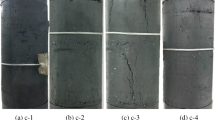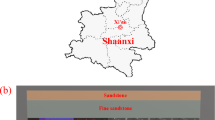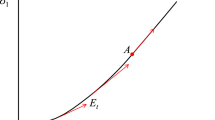Abstract
A triaxial creep model for deep coal considering temperature effect based on fractional derivative is proposed for the condition of triaxial stress state. In order to study the temperature effect on creep deformation of deep coal, the thermal damage variable is established based on the Weibull distribution and continuum damage mechanics theory. The thermal damage variable is assigned to the Hooke body and Abel dashpot in order to characterize the effect of temperature on elastic modulus and viscosity coefficient. The temperature-dependent mechanical elements are connected to the creep model, and a three-dimensional creep constitutive equation based on fractional derivative is established. A creep experimental study for deep coal under the constant axial pressure and unloading confining pressure at different temperatures is carried out to characterize the creep deformation of deep coal during mining. The experimental results show that the coal sample with higher temperature has greater axial deformation, but the radial deformation does not change monotonically with the change of temperature. Moreover, the proposed triaxial creep model is validated by experimental data and the nonlinear least square method is used to determine the model parameters. It is indicated that the triaxial creep model can better describe the time-dependent deformation under the effect of temperature, especially the accelerated creep stage of creep. In addition, the sensitivity analysis of key parameters of the proposed model, especially axial stress level and creep temperature, is carried out to further verify the accuracy of the triaxial creep model.












Similar content being viewed by others
Abbreviations
- a :
-
Temperature effect constant
- \(\alpha\) :
-
Parameter of Mittag–Leffler function
- \(\alpha _{1}\) :
-
Thermal expansion coefficient (K−1)
- b :
-
Temperature effect constant
- \(\beta\) :
-
Parameter of Mittag–Leffler function
- \(\beta _{1}\) :
-
Biot coefficient
- \(D^{\gamma }\) :
-
Fractional differential operator
- \(D_{{\text{T}}}\) :
-
Thermal damage variable
- \(D_{{\text{M}}}\) :
-
Mechanical damage variable
- \(D_{{{\text{TM}}}}\) :
-
Thermal–mechanical damage variable
- \(\varepsilon\) :
-
Strain of the Hooke body
- \(\varepsilon _{1}\) :
-
Axial strain of microunit
- \(\varepsilon (t)\) :
-
Strain of the Abel dashpot
- \(\varepsilon _{{\text{e}}}\) :
-
Strain of the Hooke body
- \(\varepsilon _{{{\text{ve}}}}\) :
-
Strain of the viscoelastic body
- \(\varepsilon _{{{\text{vp}}}}\) :
-
Strain of the viscoplastic body
- \(\varepsilon _{{\text{H}}}\) :
-
Strain of the Hooke body
- \(\varepsilon _{{\text{A}}}\) :
-
Strain of the Abel dashpot
- \(\varepsilon _{{ij}}^{'} \left( t \right)\) :
-
Total effective deviatoric strain tensor
- \(\varepsilon _{{ij}}^{e}\) :
-
Effective deviatoric strain tensor of elastic body
- \(\varepsilon _{{ij}}^{{ve}}\) :
-
Effective deviatoric strain tensor of viscoelastic body
- \(\varepsilon _{{ij}}^{{vp}}\) :
-
Effective deviatoric strain tensor of viscoplastic body
- E (T):
-
Elastic modulus at temperature T (GPa)
- \(E_{0} (T)\) :
-
Elastic modulus at temperature T (GPa)
- \(E_{1} (T)\) :
-
Elastic modulus at temperature T (GPa)
- \(E_{{\alpha ,\beta }} (z)\) :
-
Mittag–Leffler function
- \(F\) :
-
Yield function
- \(F_{0}\) :
-
Initial reference value of the yield function
- \(G_{0} (T)\) :
-
Shear modulus at temperature T (GPa)
- \(G_{1} (T)\) :
-
Shear modulus at temperature T (GPa)
- \(J_{2}\) :
-
Second invariant of deviatoric stress (MPa)
- \(K(T)\) :
-
Bulk modulus at temperature T (GPa)
- μ:
-
Poisson’s ratio
- m :
-
Shape parameter
- \(\eta _{0}^{\gamma }\) :
-
Viscosity coefficient at room temperature (GPa·hγ)
- \(\eta _{{}}^{\gamma } (T)\) :
-
Viscosity coefficient at temperature T (GPa·hγ)
- \(\eta _{1}^{\gamma } (T)\) :
-
Viscosity coefficient of the Abel dashpot at temperature T (GPa·hγ)
- \(\eta _{2}^{\gamma } (T)\) :
-
Viscosity coefficient of the Abel dashpot at temperature T (GPa·hγ)
- P :
-
Pore pressure (MPa)
- \(\gamma\) :
-
Fractional derivative order
- \(s_{{ij}}^{'}\) :
-
Effective deviatoric stress tensor
- \(\Delta T\) :
-
Change from room temperature (oC)
- \(T_{0}\) :
-
Room temperature (oC)
- \(\omega\) :
-
Parameter of viscosity coefficient (h−1)
- \(\psi\) :
-
Scale parameter
- \(\delta _{{ij}}\) :
-
Kronecker symbol
- \(\phi ( \cdot )\) :
-
Power function form
- \(\sigma\) :
-
Stress of the Hooke body (MPa)
- \(\sigma (t)\) :
-
Stress of the Abel dashpot (MPa)
- \(\sigma _{1}\) :
-
Axial stress (MPa)
- \(\sigma _{2}\) :
-
Radial stress (MPa)
- \(\sigma _{3}\) :
-
Confining pressure (MPa)
- \((\sigma _{s} )_{{\text{T}}}\) :
-
Yield limit with the temperature effect (MPa)
- \(\sigma _{{\text{d}}}\) :
-
Stress of the Abel dashpot (MPa)
- \(\sigma _{{\text{p}}}\) :
-
Stress of the fractional element (MPa)
- \(\sigma _{{\text{m}}}^{'}\) :
-
Effective spherical stress tensor
- \(\sigma _{{ij}}^{'}\) :
-
Effective stress tensor
References
Cai TT, Feng ZC, Jiang YL, Zhao D, Zhou D, Zhang XQ (2018) Seepage evolution in coal creep under different temperatures and different stresses. Chin J Rock Mech Eng 37(S2):3898-3904C (in Chinese)
Chen L, Wang CP, Liu JF, Liu YM, Liu J, Su R, Wang J (2014) A damage-mechanism-based creep model considering temperature effect in granite. Mech Res Commun 56:76–82
Chen SW, Yang CH, Wang GB (2017) Evolution of thermal damage and permeability of Beishan granite. Appl Therm Eng 110:1533–1542
Danesh NN, Chen Z, Aminossadati SM, Kizil MS, Pan Z, Connell LD (2016) Impact of creep on the evolution of coal permeability and gas drainage performance. J Nat Gas Sci Eng 33:469–482
Danesh NN, Chen Z, Connell LD, Kizil MS, Pan Z, Aminossadati SM (2017) Characterisation of creep in coal and its impact on permeability: an experimental study. Int J Coal Geol 173:200–211
Feng YY, Yang XJ, Liu JG, Chen ZQ (2021) A new fractional Nishihara-type model with creep damage considering thermal effect. Eng Fract Mech 242:107451
Gao F, Xu XL, Yang XJ, Ju Y (2009) Research on thermo-visco-elastoplastic model of rock. Chin J Rock Mech Eng 28(1):74–80 (in Chinese)
Guo ZH, Nhu Hao VuP, Hussain F (2018) A laboratory study of the effect of creep and fines migration on coal permeability during single-phase flow. Int J Coal Geol 200:61–76
Heap MJ, Baud P, Meredith PG (2009) Influence of temperature on brittle creep in sandstones. Geophys Res Lett 36(19):L19305
Hou RH, Zhang K, Tao J, Xue XR, Chen YL (2019) A nonlinear creep damage coupled model for rock considering the effect of initial damage. Rock Mech Rock Eng 52:1275–1285
Hu QZ, Feng XT, Zhou H (2009) Study of creep model of rock salt with thermal damage considered. Rock Soil Mech 30(8):2245–2248 (in Chinese)
Kang JH, Zhou FB, Liu C, Liu YK (2015) A fractional non-linear creep model for coal considering damage effect and experimental validation. Int J Non-Linear Mech 76:20–28
Liao MK, Lai YM, Liu EL, Wan XS (2017) A fractional order creep constitutive model of warm frozen silt. Acta Geotech 12:377–389
Liu QS, Xu XC, Yamaguchi T, Cho A (2001) Testing study on mechanical properties of the three gorges granite concerning temperature and time. Chin J Rock Mech Eng 20(5):715–719 (in Chinese)
Li BB, Yang K, Xu P, Xu J, Yuan M, Zhang M (2019) An experimental study on permeability characteristics of coal with slippage and temperature effects. J Petrol Sci Eng 175:294–302
Li BB, Yang K, Ren CH, Li JH, Xu J (2019) An adsorption-permeability model of coal with slippage effect under stress and temperature coupling condition. J Nat Gas Sci Eng 71:102983
Mansouri H, Ajalloeian R (2018) Mechanical behavior of salt rock under uniaxial compression and creep tests. Int J Rock Mech Min Sci 110:19–27
Nagel T, Minkley W, Böttcher N, Naumov D, Görke UJ, Kolditz O (2017) Implicit numerical integration and consistent linearization of inelastic constitutive models of rock salt. Comput Struct 182:87–103
Nishihara M (1952) Creep of shale and sandy-shale. J Geol Soc Jpn 58(683):373–377
Noack K (1998) Control of gas emissions in underground coal mines. Int J Coal Geol 35:57–82
Qi YJ, Jiang QH, Wang ZJ, Zhou CB (2012) 3D creep constitutive equation of modified Nishihara model and its parameters identification. Chin J Rock Mech Eng 31(2):347–355 (in Chinese)
Ren CH, Li BB, Xu J, Zhang Y, Li JH, Gao Z, Yu J (2020) A novel damage-based permeability model for coal in the compaction and fracturing process under different temperature conditions. Rock Mech Rock Eng 53:5697–5713
Schoenball M, Sahara DP, Kohl T (2014) Time-dependent brittle creep as a mechanism for time-delayed wellbore failure. Int J Rock Mech Min Sci 70:400–406
Shao JF, Chau KT, Feng XT (2006) Modeling of anisotropic damage and creep deformation in brittle rocks. Int J Rock Mech Min Sci 43:582–592
Ulusay R, Hudson JA (2007) The complete ISRM suggested methods for rock characterization, testing and monitoring: 1974–2006 In: Suggested Methods Prepared by the ISRM Commission on Testing Methods. International Society for Rock Mechanics, Lisbon
Wang LJ, Zhou HW, Rong TL, Ren WG (2018) Research on experimental and nonlinear creep constitutive model of coal at depth. J China Coal Soc 43(8):2196–2203 (in Chinese)
Wang JM, Zhao YS, Mao RB (2019) Impact of temperature and pressure on the characteristics of two-phase flow in coal. Fuel 253:1325–1332
Wu F, Chen J, Zou QL (2018) A nonlinear creep damage model for salt rock. Int J Damage Mech 28(5):758–771
Xu WY, Yang SQ, Chu WJ (2006) Nonlinear viscoelasto-plastic rheological model(Hohai model) of rock and its engineering application. Chin J Rock Mech Eng 25(3):433–447 (in Chinese)
Xu HY, Jiang XY (2017) Creep constitutive models for viscoelastic materials based on fractional derivatives. Comput Math Appl 73(6):1377–1384
Xu XL, Karakus M (2018) A coupled thermo-mechanical damage model for granite. Int J Rock Mech Min Sci 103:195–204
Xu T, Zhou GL, Heap MJ, Zhu WC, Chen CF, Baud P (2017) The influence of temperature on time-dependent deformation and failure in granite: a mesoscale modeling approach. Rock Mech Rock Eng 50(9):2345–2364
Yang SQ, Xu P, Xu T (2015) Nonlinear visco-elastic and accelerating creep model for coal under conventional triaxial compression. Geomech Geophys Geo-Energy Geo-Resour 1:109–120
Yin GZ, Jiang CB, Wang JG, Xu J (2013) Combined effect of stress, pore pressure and temperature on methane permeability in anthracite coal: an experimental study. Transp Porous Media 100:1–16
Zhang L, Li XC, Ren T (2020) A theoretical and experimental study of stress–strain, creep and failure mechanisms of intact coal. Rock Mech Rock Eng 53:5641–5658
Zhao YL, Wang YX, Wang WJ, Wan W, Tang JZ (2017) Modeling of non-linear rheological behavior of hard rock using triaxial rheological experiment. Int J Rock Mech Min Sci 93:66–75
Zhao Y, Lin BQ, Liu T, Zheng YN, Kong J, Li QZ, Song HR (2019) Flow field evolution during gas depletion considering creep deformation. J Nat Gas Sci Eng 65:45–55
Zhao Y, Zhou HW, Zhong JC, Liu D (2019) Study on the relation between damage and permeability of sandstone at depth under cyclic loading. Int J Coal Sci Technol 6(4):479–492
Zhou FX, Wang LY, Liu HB (2021) A fractional elasto-viscoplastic model for describing creep behavior of soft soil. Acta Geotech 16:67–76
Zhou HW, Wang CP, Han BB, Duan ZQ (2011) A creep constitutive model for salt rock based on fractional derivatives. Int J Rock Mech Min Sci 48(1):116–121
Zhou HW, Wang CP, Mishnaevsky L, Duan ZQ, Ding JY (2013) A fractional derivative approach to full creep regions in salt rock. Mech Time-Depend Mater 17(3):413–425
Zhou HW, Wang LJ, Rong TL, Zhang L, Ren WG, Su T (2019) Creep-based permeability evolution in deep coal under unloading confining pressure. J Nat Gas Sci Eng 65:185–196
Zhou HW, Zhang L, Wang XY, Rong TL, Wang LJ (2020) Effects of matrix-fracture interaction and creep deformation on permeability evolution of deep coal. Int J Rock Mech Min Sci 127:104236
Acknowledgements
The present work is supported by the National Natural Science Foundation of China (51674266, 51827901, 51904309) and the Yueqi Outstanding Scholar Program of CUMTB (2017A03). The financial supports are gratefully acknowledged.
Author information
Authors and Affiliations
Corresponding author
Ethics declarations
Conflict of interest
The authors wish to confirm that there are no known conflicts of interest associated with this publication.
Additional information
Publisher's Note
Springer Nature remains neutral with regard to jurisdictional claims in published maps and institutional affiliations.
Rights and permissions
About this article
Cite this article
Zhang, L., Zhou, H., Wang, X. et al. A triaxial creep model for deep coal considering temperature effect based on fractional derivative. Acta Geotech. 17, 1739–1751 (2022). https://doi.org/10.1007/s11440-021-01302-w
Received:
Accepted:
Published:
Issue Date:
DOI: https://doi.org/10.1007/s11440-021-01302-w




